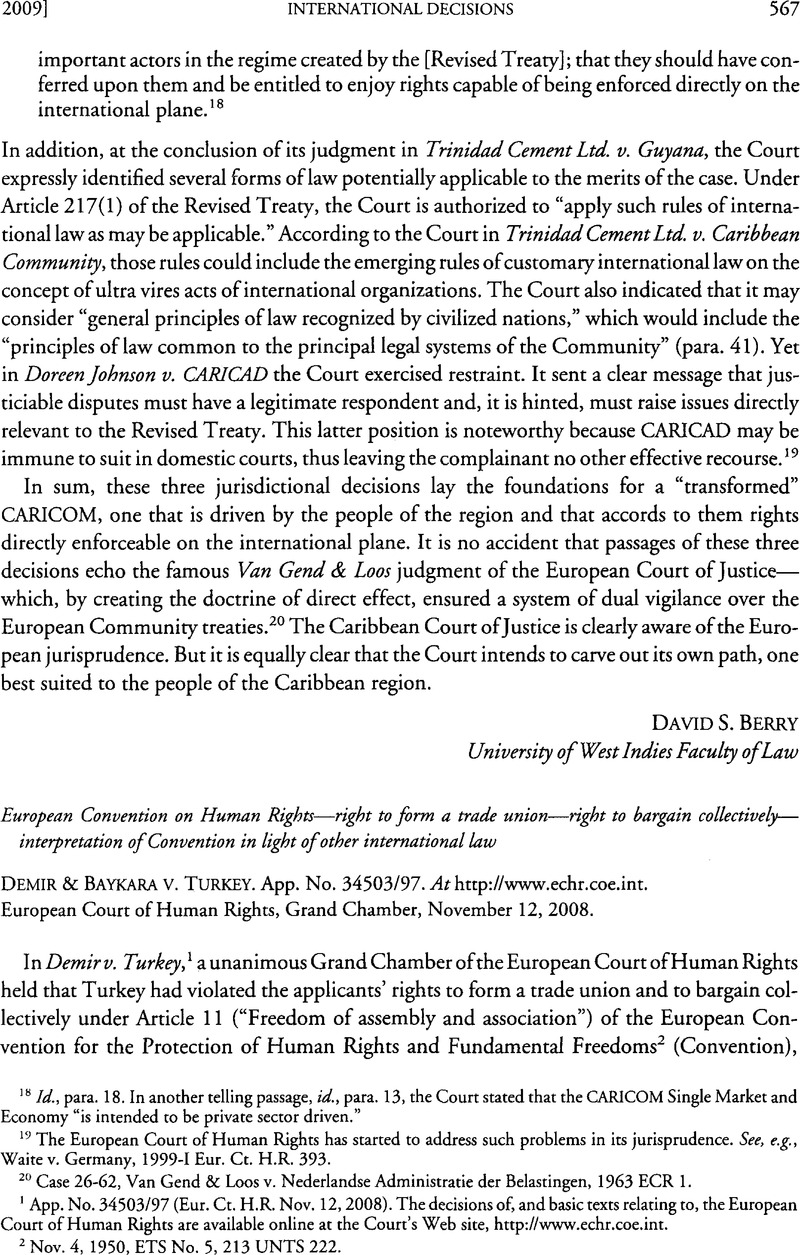Published online by Cambridge University Press: 10 March 2017

1 App. No. 34503/97 (Eur. Ct. H.R. Nov. 12,2008). The decisions of, and basic texts relating to, the European Court of Human Rights are available online at the Court’s Web site, http://www.echr.coe.int.
2 Nov. 4, 1950, ETS No. 5, 213 UNTS 222.
3 Article 11 provides:
1. Everyone has the right to freedom of peaceful assembly and to freedom of association with others, including the right to form and to join trade unions for the protection of his interests.
2. No restrictions shall be placed on the exercise of these rights other than such as are prescribed by law and are necessary in a democratic society in the interests of national security or public safety, for the prevention of disorder or crime, for the protection of health or morals or for the protection of the rights and freedoms of others. This article shall not prevent the imposition of lawful restrictions on the exercise of these rights by members of the armed forces, of the police or of the administration of the State.
4 Vienna Convention on the Law of Treaties, May 23, 1969, 1155 UNTS 331. Under Article 31(3) (c), “There shall be taken into account, together with the context: . . . (c) any relevant rules of international law applicable in the relations between the parties.”
5 Golder v. United Kingdom, App. No. 4451/70 (Eur. Ct. H.R. Feb. 21, 1975).
6 161 Eur. Ct. H.R. (ser. A) (1989), 28 ILM 1063 (1989); see Richard B. Lillich, The Soering Case, 85 AJIL 128 (1991).
7 The Court made reference to Article 8(2) of the International Covenant on Economic, Social and Cultural Rights, Article 22 of the International Covenant on Civil and Political Rights; Article 2 of ILO Convention No. 87; Article 5 of the European Social Charter; and Article 12(1) of the European Union’s Charter of Fundamental Rights.
8 The early classical cases were National Union of Belgian Police v. Belgium, 19 Eur. Ct. H.R. (ser. A) (1975), and Swedish Engine Drivers’Union v. Sweden, 20 Eur. Ct. H.R. (ser. A) (1976). This Court has revisited (and reaffirmed) this case law more recently in the admissibility decisions Schettini v. Italy, App. No. 29529/95 (Eur. Ct. H.R. Nov. 9, 2000), and UNISON v. United Kingdom, App. No. 53574/99 (Eur. Ct. H.R. Jan. 10, 2002).
9 See, for example, the Court’s formulations of this approach in Al-Adsani v. United Kingdom, 2001 -XI Eur. Ct. H.R. 79, para. 55, in which it stated that the Convention “cannot be interpreted in a vacuum” and that it “should so far as possible be interpreted in harmony with other rules of international law ofwhich it forms part.” The Court’s approach‘m Al-Adsani was among the sources that the International Law Commission relied on in its study of the “fragmentation of international law,” see infra notes 13-16 and accompanying text.
10 See Oil Platforms (Iran v. U.S.), 2003ICJ Rep. 161, para. 41 (Nov. 6); id. at 225, paras. 45-49 (sep. op. Hig- gins, J.); id. at 270, paras. 21-24, 28 (sep. op. Buergenthal, J.); id. at 324, para. 9 (sep. op. Simma, J.); see also Panel Report, European Communities—Measures Affecting the Approval and Marketing of Biotech Products, WT/DS291-293/R, paras. 7.67-.72 (adopted Nov. 21, 2006); Belgium v. Netherlands, Award, paras. 58, 79 (Perm. Ct. Arb. May 24, 2005); Ireland v. United Kingdom, Final Award, paras. 101-05 (Perm. Ct. Arb. July 2, 2003); id., Diss. Op. Griffith, Arb., paras. 2(2), 9, 19. Documents for arbitrations under the auspices of the Permanent Court of Arbitration are available at http://www.pca-cpa.org.
11 For examples of cases, see supra note 10. For a comprehensive treatment of the provision in a recent publication on treaty interpretation in general, see Gardiner, Richard Treaty Interpretation 250–91 (2008)Google Scholar. For articles devoted specifically to an examination of the provision, see, for example, Sands, Philippe Treaty, Custom and the Cross-fertilization of International Law, 1 Yale Hum. Rts. & Dev. L.J. 102 (1998)Google Scholar; McLachlan, Campbell The Principle of Systemic Integration and Article 31(3)(c) of the Vienna Convention, 54 Int’l & Comp. L.Q. 279 (2005)CrossRefGoogle Scholar; French, Duncan Treaty Interpretation and the Incorporation of Extraneous Legal Rules, 55 Int’l & Comp. L.Q. 281 (2006).CrossRefGoogle Scholar
12 Of the vast amount of literature on fragmentation, see, for example, Simma, Bruno Self Contained Regimes, 1985 Neth. Y.B. Int’l L. IIIGoogle Scholar; Simma, Bruno & Pulkowski, Dirk Of Planets and the Universe: Self-Contained Regimes in International Law, 17 Eur. J. Int’l L. 483 (2006)Google Scholar; Koskenniemi, Martti & Päivi, Leino Fragmentation of International Law?: Postmodern Anxieties, 15 Leiden J. Int’l L. 553 (2002)CrossRefGoogle Scholar; Hafner, Gerhard Pros and Cons Ensuingfrom Fragmentation of International Law, 25 Mich. J. Int’l L. 849 (2004)Google Scholar. See also the collection of articles in the symposium issue The Proliferation of International Tribunals: Piecing Together the Puzzle, 31 N.Y.U. J. Int’l L. & Pol. 679 (1999).Google Scholar
13 International Law Commission, Fragmentation of International Law: Difficulties Arising from the Diversification and Expansion of International Law, Report of the Study Group of the International Law Commission, Finalized by Martti Koskenniemi, UN Doc. A/CN.4/L.682 (2006) [hereinafter Koskenniemi Study].
14 International Law Commission, Report on the Work of Its Fifty-eighth Session, UN GAOR, 61st Sess., Supp. No. 10, at 403,407, UN Doc. A/61/10 (2006) (Fragmentation of International Law, Report of the Study Group, Conclusion 1).
15 Id. at 413 (Conclusion 17).
16 Id.
17 Andrejeva v. Latvia, App. No. 55707/00 (Eur. Ct. H.R. Feb. 18, 2009).
18 Id., Partly Diss. Op. Ziemele, J., paras. 18-19.
19 Id., para. 17 (referring to Koskenniemi Study, supra note 13, para. 465).
20 Id., para. 41.